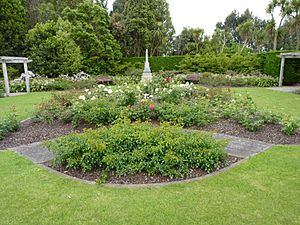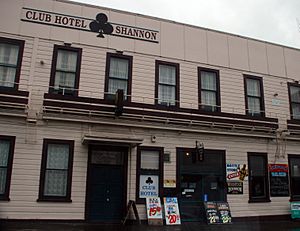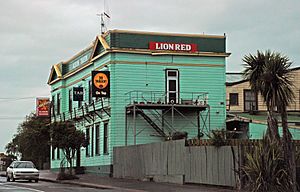Shannon, New Zealand facts for kids
Quick facts for kids
Shannon
|
|
|---|---|
|
Town
|
|

Te Maire Park
|
|
| Country | New Zealand |
| Region | Manawatū-Whanganui region |
| Territorial authority | Horowhenua District |
| Wards |
|
| Founded by | Wellington and Manawatu Railway Company. |
| Named for | George Vance Shannon |
| Electorates |
|
| Area | |
| • Total | 2.94 km2 (1.14 sq mi) |
| Population
(June 2023)
|
|
| • Total | 1,610 |
| • Density | 547.6/km2 (1,418/sq mi) |
| Time zone | UTC+12 (NZST) |
| • Summer (DST) | UTC+13 (NZDT) |
| Postcode |
4821
|
| Area Code | 06 |
Shannon is a small town in New Zealand. You can find it on the North Island, in the Horowhenua District. It's about 28 kilometers southwest of Palmerston North and 15 kilometers northeast of Levin.
People in Shannon mostly work in farming, raising dairy cows, sheep, and other animals. A nearby town called Mangaore (5 kilometers east) is home to workers from the Mangahao hydro-electric power station. This power station was the second one built in New Zealand and the first by the government. It's also the oldest power station still providing electricity to New Zealand today. The Manawatū River flows to the west of Shannon. Many people in Shannon are Māori, and the local primary school teaches using kaupapa Māori principles.
Contents
History of Shannon
Shannon was once surrounded by large swampy areas. It was a main center for processing flax, a plant used for fibers. The land where the town now stands was bought around 1881 by the Wellington and Manawatu Railway Company (WMR).
The company first planned to extend its railway to Foxton. But then, they decided to develop the land they owned. So, the railway line was built through Shannon. The town is considered to have started on March 8, 1887. This was when the first pieces of town land were sold at an auction. Shannon was named after George Vance Shannon, who was a director of the WMR. It officially became a borough (a type of town) in 1917.
Mangahao Power Station Accident
On July 2, 1922, a sad accident happened during the building of the Mangahao Power Station. Seven workers were affected by carbon monoxide while digging tunnels.
The extractor fan, which pulled out bad air, stopped working. This caused Bernard Butler and foreman Alfred Maxwell to become unwell from engine fumes. A group of five other workers went into the tunnel to help. Sadly, they also became unwell and passed away in the tunnel.
Population of Shannon
Shannon is considered a small urban area by Statistics New Zealand. It covers about 2.94 square kilometers. As of June 2023, it has an estimated population of 1,610 people. This means there are about 548 people living in each square kilometer.
In the 2018 New Zealand census, Shannon had 1,398 residents. This was an increase of 162 people since the 2013 census. There were 537 homes in the town. The average age of people in Shannon was 40.4 years.
Many different groups of people live in Shannon. About 78.5% of residents are European/Pākehā. Around 43.1% are Māori. Smaller groups include Pasifika (2.8%) and Asian (1.7%).
Things to Do and See in Shannon
Today, Shannon is a convenient stop for travelers between Palmerston North, Horowhenua, Kapiti, and Wellington. The town has public toilets, two cafes, a dairy, and a fish and chip shop. You can also find an RD1 rural supply store, a Four Square grocery store, a petrol station, and an art gallery.
For sports, Shannon has clubs for rugby, netball, and lawn bowling.
The Shannon Railway Station is one of the few remaining parts of the old WMR railway. The national New Zealand Railways Department took over this railway in 1908. The station is a stop for the Capital Connection train. This train travels between Wellington and Palmerston North.
Owlcatraz Wildlife Park
Owlcatraz was a popular wildlife park in Shannon. It was home to many native birds and other animals. Ross and Janet Campbell opened it in 1997. They ran it for 23 years, welcoming over one million visitors.
Helen's Model Town
Shannon used to display a special creation by Helen Pratt. She built a large model town with tiny versions of many famous New Zealand buildings and landmarks. It even had a working train and a carnival! Everything was made by hand. This display was once at 36 Stout Street. Helen later built another model town. This collection was shown for a short time at 16 Ballance Street, called Flaxville. Helen's collection has since moved from Shannon. It was later displayed at Murrayfield, a museum between Shannon and Levin.
Education in Shannon
Shannon School is a primary school for students in Year 1 to Year 8. It teaches both boys and girls. As of February 2024, it has a roll of 96 students.
For high school, students can go to schools in nearby towns. Levin and Foxton are both a short 10–16 minute drive away. These towns offer three high school choices: Waiopehu College, Horowhenua College, and Manawatū College.
Students might also consider high schools in Palmerston North, a larger city. It's about a 20–30 minute drive from Shannon.



